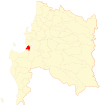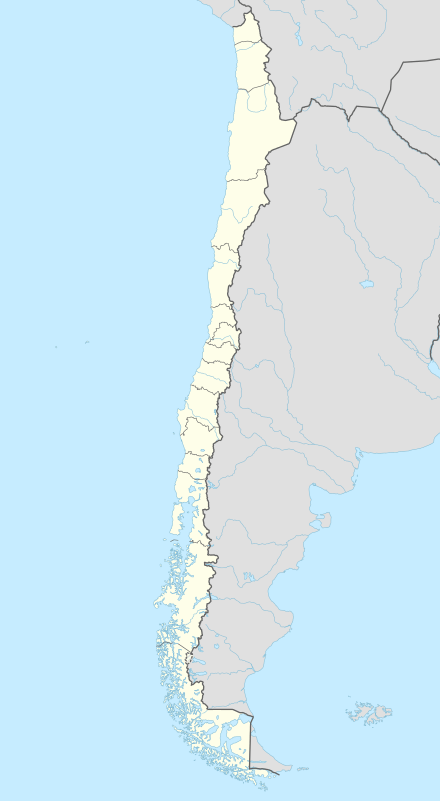Lota, Chile
| Lota | |||||
|---|---|---|---|---|---|
| City and Commune | |||||
|
Dusk in Lota | |||||
| |||||
| Coordinates: 37°05′S 73°10′W / 37.083°S 73.167°WCoordinates: 37°05′S 73°10′W / 37.083°S 73.167°W | |||||
| Country | Chile | ||||
| Region | Biobío | ||||
| Province | Concepción | ||||
| Founded | 1662 | ||||
| Founded as | Santa María de Guadalupe | ||||
| Government[1][2] | |||||
| • Type | Municipality | ||||
| • Alcalde | Patricio Marchant Ulloa (PDC) | ||||
| Area[3] | |||||
| • Total | 135.8 km2 (52.4 sq mi) | ||||
| Elevation | 82 m (269 ft) | ||||
| Population (2012 Census)[3] | |||||
| • Total | 47,339 | ||||
| • Density | 350/km2 (900/sq mi) | ||||
| • Urban | 48,975 | ||||
| • Rural | 114 | ||||
| Sex[3] | |||||
| • Men | 23,944 | ||||
| • Women | 25,145 | ||||
| Time zone | CLT (UTC−4) | ||||
| • Summer (DST) | CLST (UTC−3) | ||||
| Area code(s) | 56 + 41 | ||||
| Website | Official website (Spanish) | ||||
Lota is a city and commune located in the center of Chile on the Gulf of Arauco, in the southern Concepción Province of the Biobío Region, 39 kilometres south of Concepción, and is one of the ten cities(communes) that constitutes the Concepción metropolitan area.
History
The first Spanish settlement, Santa Maria de Guadalupe, was founded by the governor Ángel de Peredo on October 12, 1662 but it did not survive long amidst the hostilities of the Arauco War. The modern city expanded with the coal mining industry in the mid-nineteenth century. It was established as a town on January 5, 1875 and became a city on November 30, 1881. The name Lota is thought to be derived from the Mapudungun word Louta meaning small or insignificant settlement.
The city's coal mines were nationalized by Salvador Allende due to civil unrest and heavy Socialist support, but privatized again under Augusto Pinochet.[4] The mines were closed in the 1990s after Lota's coal resources were nearly exhausted and cheaper Colombian coal arrived on the market, plunging the residents of Lota into poverty.
Today, Lota is one of the poorest cities in Chile and is trying to turn its economy towards tourism. Tourist attractions include guided visits to the coal mine, White Beach, the Park of Lota (created by the Cousiño family), and the Historical Museum of Lota. Lota also has Chile's oldest hydroelectric power station, the Chivilingo Hydroelectric Plant, designed by Thomas Edison and built in 1897.
Points of interest
- Chivilingo Hydroelectric Plant
- El Chiflón del Diablo
- Parque Isidora Goyenechea de Cousiño
- Pabellòn 83
Demographics
According to the 2002 census of the National Statistics Institute, Lota spans an area of 135.8 km2 (52 sq mi) and has 49,089 inhabitants (23,944 men and 25,145 women). Of these, 48,975 (99.8%) lived in urban areas and 114 (0.2%) in rural areas. The population fell by 2.3% (1167 persons) between the 1992 and 2002 censuses.[3]
Administration
As a commune, Lota is a third-level administrative division of Chile administered by a municipal council, headed by an alcalde who is directly elected every four years. The 2008-2012 alcalde is Patricio Marchant Ulloa([Christian Democratic Party (Chile)|PDC].[1][2]
Within the electoral divisions of Chile, Lota is represented in the Chamber of Deputies by Manuel Monsalve (PS) and Iván Norambuena (UDI) as part of the 46th electoral district, (together with Lota, Lebu, Arauco, Curanilahue, Los Álamos, Cañete, Contulmo and Tirúa). The commune is represented in the Senate by Victor Pérez Varela (UDI) and Mariano Ruiz -Esquide Jara (PDC) as part of the 13th senatorial constituency (Biobío-Coast).
References
- 1 2 "Asociación Chilena de Municipalidades" (in Spanish). Retrieved 23 February 2011.
- 1 2 "Municipality of Lota" (in Spanish). Retrieved 23 February 2011.
- 1 2 3 4 "National Statistics Institute" (in Spanish). Retrieved 13 December 2010.
- ↑ Clifford Krauss, Chile's Leader Remains Socialist but Acts Like Pragmatist, Copyright 2001 The New York Times Company. December 10, 2001, Monday, Late Edition - Final
External links
| Wikimedia Commons has media related to Lota, Chile. |
- (Spanish) Municipality of Lota
- (Spanish) fair of Lota




